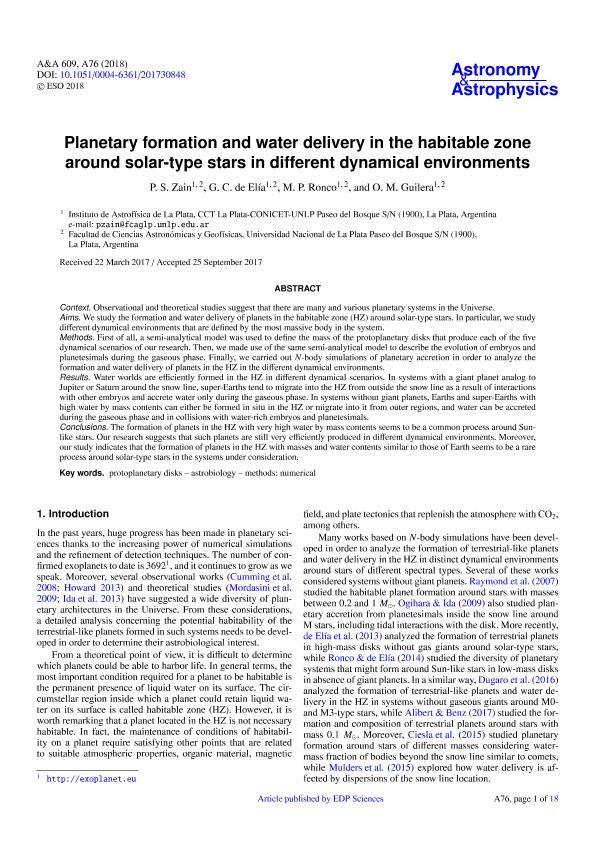Mostrar el registro sencillo del ítem
dc.contributor.author
Zain, Patricio Salvador

dc.contributor.author
de Elia, Gonzalo Carlos

dc.contributor.author
Ronco, María Paula

dc.contributor.author
Guilera, Octavio Miguel

dc.date.available
2019-09-04T17:30:48Z
dc.date.issued
2018-01
dc.identifier.citation
Zain, Patricio Salvador; de Elia, Gonzalo Carlos; Ronco, María Paula; Guilera, Octavio Miguel; Planetary formation and water delivery in the habitable zone around solar-type stars in different dynamical environments; EDP Sciences; Astronomy and Astrophysics; 609; A76; 1-2018; 1-18
dc.identifier.issn
0004-6361
dc.identifier.uri
http://hdl.handle.net/11336/82885
dc.description.abstract
Context. Observational and theoretical studies suggest that there are many and various planetary systems in the Universe. Aims. We study the formation and water delivery of planets in the habitable zone (HZ) around solar-type stars. In particular, we study different dynamical environments that are defined by the most massive body in the system. Methods. First of all, a semi-analytical model was used to define the mass of the protoplanetary disks that produce each of the five dynamical scenarios of our research. Then, we made use of the same semi-analytical model to describe the evolution of embryos and planetesimals during the gaseous phase. Finally, we carried out N-body simulations of planetary accretion in order to analyze the formation and water delivery of planets in the HZ in the different dynamical environments. Results. Water worlds are efficiently formed in the HZ in different dynamical scenarios. In systems with a giant planet analog to Jupiter or Saturn around the snow line, super-Earths tend to migrate into the HZ from outside the snow line as a result of interactions with other embryos and accrete water only during the gaseous phase. In systems without giant planets, Earths and super-Earths with high water by mass contents can either be formed in situ in the HZ or migrate into it from outer regions, and water can be accreted during the gaseous phase and in collisions with water-rich embryos and planetesimals. Conclusions. The formation of planets in the HZ with very high water by mass contents seems to be a common process around Sun-like stars. Our research suggests that such planets are still very efficiently produced in different dynamical environments. Moreover, our study indicates that the formation of planets in the HZ with masses and water contents similar to those of Earth seems to be a rare process around solar-type stars in the systems under consideration.
dc.format
application/pdf
dc.language.iso
eng
dc.publisher
EDP Sciences

dc.rights
info:eu-repo/semantics/openAccess
dc.rights.uri
https://creativecommons.org/licenses/by-nc-sa/2.5/ar/
dc.subject
Astrobiology
dc.subject
Methods: Numerical
dc.subject
Protoplanetary Disks
dc.subject.classification
Astronomía

dc.subject.classification
Ciencias Físicas

dc.subject.classification
CIENCIAS NATURALES Y EXACTAS

dc.title
Planetary formation and water delivery in the habitable zone around solar-type stars in different dynamical environments
dc.type
info:eu-repo/semantics/article
dc.type
info:ar-repo/semantics/artículo
dc.type
info:eu-repo/semantics/publishedVersion
dc.date.updated
2019-08-30T14:27:52Z
dc.journal.volume
609
dc.journal.number
A76
dc.journal.pagination
1-18
dc.journal.pais
Francia

dc.journal.ciudad
Paris
dc.description.fil
Fil: Zain, Patricio Salvador. Consejo Nacional de Investigaciones Científicas y Técnicas. Centro Científico Tecnológico Conicet - La Plata. Instituto de Astrofísica La Plata. Universidad Nacional de La Plata. Facultad de Ciencias Astronómicas y Geofísicas. Instituto de Astrofísica La Plata; Argentina
dc.description.fil
Fil: de Elia, Gonzalo Carlos. Consejo Nacional de Investigaciones Científicas y Técnicas. Centro Científico Tecnológico Conicet - La Plata. Instituto de Astrofísica La Plata. Universidad Nacional de La Plata. Facultad de Ciencias Astronómicas y Geofísicas. Instituto de Astrofísica La Plata; Argentina
dc.description.fil
Fil: Ronco, María Paula. Consejo Nacional de Investigaciones Científicas y Técnicas. Centro Científico Tecnológico Conicet - La Plata. Instituto de Astrofísica La Plata. Universidad Nacional de La Plata. Facultad de Ciencias Astronómicas y Geofísicas. Instituto de Astrofísica La Plata; Argentina
dc.description.fil
Fil: Guilera, Octavio Miguel. Consejo Nacional de Investigaciones Científicas y Técnicas. Centro Científico Tecnológico Conicet - La Plata. Instituto de Astrofísica La Plata. Universidad Nacional de La Plata. Facultad de Ciencias Astronómicas y Geofísicas. Instituto de Astrofísica La Plata; Argentina
dc.journal.title
Astronomy and Astrophysics

dc.relation.alternativeid
info:eu-repo/semantics/altIdentifier/doi/http://dx.doi.org/10.1051/0004-6361/201730848
dc.relation.alternativeid
info:eu-repo/semantics/altIdentifier/url/https://www.aanda.org/10.1051/0004-6361/201730848
Archivos asociados
